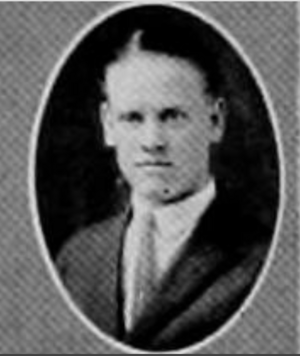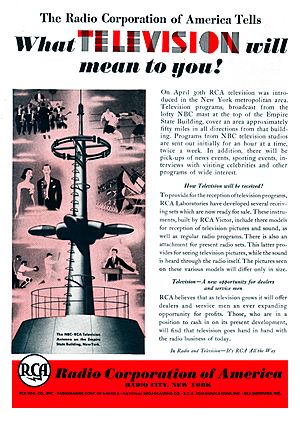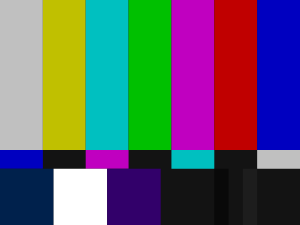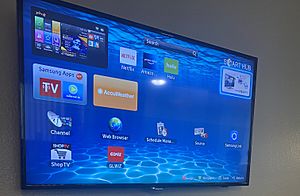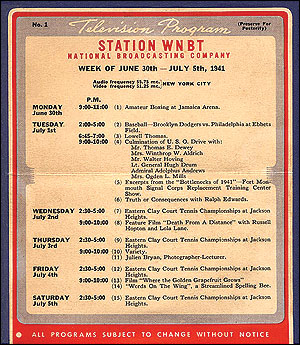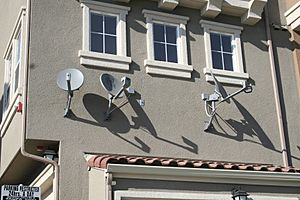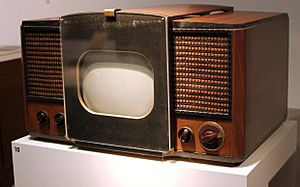History of television facts for kids
Television, or TV, is a way to send moving pictures and sound over long distances. Many smart people worked on this idea in the late 1800s and early 1900s. At first, TV used spinning disks with tiny holes to scan images. This was called "mechanical television." Then, World War II paused these developments. After the war, TV became all-electronic, using special tubes to create and show pictures. Different countries developed their own ways to add color to TV.
After the war, TV quickly became very popular. It was used for advertising, sharing important messages, and for fun shows. TV signals can travel through the air using radio waves, from satellites in space, or through wires called cable TV. Many countries now use digital television, which gives clearer pictures and more features. You can also watch TV shows over the Internet.
TV shows are paid for in different ways. Some get money from commercials. Others are supported by private groups or governments. In some places, people pay a special fee to own a TV. Some services, especially on cable or satellite, require a monthly payment. TV technology keeps getting better, with things like long-distance networks and ways to record shows.
Contents
- How Mechanical Television Worked
- Electronic Television Takes Over
- Color Television Arrives
- Digital Television: The New Era
- Smart Television: TV Meets the Internet
- 3D Television: A New Dimension
- Terrestrial Television: Over the Air
- Cable Television: Wires to Your Home
- Satellite Television: From Space to Your Screen
- Internet Television: TV on the Web
- Television Sets: From Tubes to Flat Screens
- Cool TV Innovations
- Television Pioneers
- Television Museums
- See also
How Mechanical Television Worked
Early ideas for sending pictures came from facsimile transmission systems in the 1800s. An inventor named Alexander Bain created a fax machine between 1843 and 1846. Later, Giovanni Caselli, an Italian priest, made the first working fax system for telegraph lines around 1856.
In 1873, an English engineer, Willoughby Smith, found that the element selenium could change light into electricity. This discovery helped lead to ways of sending still pictures over phone lines and later to TV cameras.
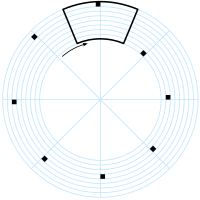
In 1884, a German student named Paul Nipkow invented and patented the Nipkow disk. This was a spinning disk with holes arranged in a spiral. Each hole scanned a different line of an image. Even though Nipkow never built a working model, his idea was used in many early TV systems. The word "television" was first used by Constantin Perskyi in 1900 at a big fair in Paris. It wasn't until 1907 that new amplifier tubes made Nipkow's design practical.
In 1906, Augusto Bissiri showed the first transmission of a photo from one room to another. Later, in 1917, he sent an image from London to New York City.
In 1909, Georges Rignoux and A. Fournier in Paris showed how to send images instantly. They used 64 selenium cells as an "electronic eye." The image they sent was only 8x8 pixels, just enough to see letters clearly.
In 1911, Boris Rosing and his student Vladimir Zworykin used a mechanical scanner to send "very crude images" over wires to a cathode-ray tube (CRT) screen. But moving images weren't possible yet.
Archibald Low showed his "Televista" system in London in 1914. People called it "Seeing By Wireless." His system used a special camera and receiver with spinning rollers to scan images. It was different from other TV systems and had some ideas similar to today's digital television. However, the First World War interrupted his work. Low's system struggled because the selenium cells he used were too slow.
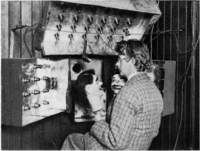
In 1923, Scottish inventor John Logie Baird started working on a complete TV system using the Nipkow disk. On March 25, 1925, Baird showed the first public demonstration of moving silhouette images at a department store in London. He used a dummy named "Stooky Bill" because human faces didn't show up well. On January 26, 1926, he showed real human faces to scientists. This is often seen as the world's first public TV demonstration. Baird's system used Nipkow disks to both scan and display the image. He started with 16 lenses and 32 lines, then improved it to 12.5 frames per second and 30 lines.
In 1927, Baird sent a TV signal over 438 miles (705 km) of telephone line between London and Glasgow. In 1928, his company sent the first TV signal across the Atlantic Ocean, from London to New York. In 1929, he helped start the first experimental mechanical TV service in Germany.
Another American inventor, Charles Francis Jenkins, also worked on television. In December 1923, he transmitted moving silhouette images. On June 13, 1925, Jenkins publicly showed synchronized silhouette pictures. He used a Nipkow disk to send the image of a toy windmill five miles.
On December 25, 1926, Kenjiro Takayanagi in Japan showed a TV system with 40 lines using a Nipkow disk and a CRT screen. By 1927, he improved it to 100 lines. In Japan, he is seen as the person who created the first all-electronic television.
In 1927, Bell Telephone Laboratories showed TV transmission from Washington to New York. They used a large, flat screen with 2500 pixels. Herbert E. Ives and Frank Gray from Bell Labs gave an impressive demonstration on April 7, 1927. Their system showed clear, moving black-and-white images with sound. They transmitted images over both wires and radio waves.
In 1928, WRGB in Schenectady, New York, started as the world's first TV station.
In the Soviet Union, Léon Theremin developed a mirror-drum TV system. By 1927, he achieved 100 lines of resolution.
Mechanical TV systems usually had low image quality, from about 30 to 120 lines. This was because only a limited number of holes could be made in the spinning disks. However, the quality improved over time. By 1933, TV broadcasts in the UK were very clear.
The development of all-electronic television eventually replaced mechanical systems. Mechanical TV was the main type until the 1930s. The last mechanical TV broadcasts in the United States ended in 1939.
Electronic Television Takes Over
In 1897, J. J. Thomson showed how to bend cathode rays, which is key to how modern cathode-ray tubes (CRTs) work. The first CRT, also called the Braun tube, was invented by German physicist Karl Ferdinand Braun in 1897. Braun was the first to think of using a CRT as a display. This tube became the basis for 20th-century television.
In 1908, Alan Archibald Campbell-Swinton suggested using a CRT for both sending and receiving TV pictures. He expanded on this idea in 1911. The first CRT to use a "hot cathode" (which made it more stable) was developed by John B. Johnson and Harry Weiner Weinhart in 1922.
Early electronic cameras had a big problem: they weren't sensitive enough to light. This meant they couldn't produce a strong enough electrical signal. This problem was solved by Hungarian engineer Kálmán Tihanyi in 1924. He developed the idea of "charge storage" within the camera tube. This meant the tube could collect and store electrical charges from light during each scan. His idea, patented in 1926, is still a basic principle in TV cameras today.
On September 7, 1927, Philo Farnsworth's "image dissector" camera tube sent its first image, a simple straight line. This happened in his lab in San Francisco. By September 3, 1928, Farnsworth showed his system to the press. This is often seen as the first electronic television demonstration. In 1929, he made his system even better by removing mechanical parts. That year, Farnsworth sent the first live images of human faces.
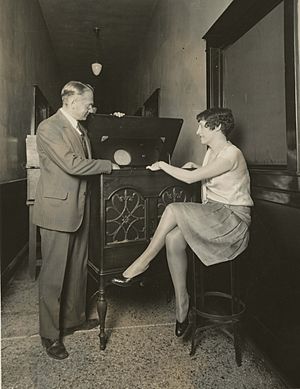
Meanwhile, Vladimir Zworykin was also working on CRTs for TV. In 1923, he started developing an electronic camera tube. However, his early demonstrations in 1925 showed dim, low-contrast images. RCA, a big company, bought Zworykin's patent. They tried to claim that Farnsworth's invention was too similar to Zworykin's earlier ideas. But in 1935, the U.S. Patent Office decided that Farnsworth was the true inventor. In 1939, RCA agreed to pay Farnsworth a lot of money to use his patents.
In 1933, RCA introduced an improved camera tube called the "Iconoscope," which used Tihanyi's charge storage idea. It was much more sensitive to light than Farnsworth's image dissector. However, Farnsworth had also invented a device called a "multipactor" that could greatly boost his signal.
At the Berlin Radio Show in August 1931, Manfred von Ardenne showed a TV system that used CRTs for both sending and receiving. This was the first fully electronic TV transmission. He used the CRT to scan slides and film. The world's first electronic TV service started in Berlin in 1935. It even broadcast the 1936 Summer Olympic Games live to public places across Germany.
Philo Farnsworth gave the world's first public demonstration of an all-electronic TV system with a live camera in Philadelphia on August 25, 1934.
In Britain, the EMI team, led by Isaac Shoenberg, developed a new camera tube called the "Emitron" in 1932. In November 1936, the BBC started a 405-line broadcasting service using the Emitron. This was the world's first regular high-definition TV service. It was more reliable and looked better than Baird's mechanical system.
In 1934, Zworykin shared some patent rights with the German company Telefunken. This led to the "image iconoscope" (called "Superikonoskop" in Germany), which was similar to EMI's super-Emitron. This tube became the standard for public broadcasting in Europe from 1936 until the 1960s.
In the U.S., different TV technologies were used until standards were agreed upon in 1941. RCA used Iconoscopes in New York but Farnsworth's Image Dissectors in other cities. After their agreement in 1939, RCA combined the best of Farnsworth's technology into their systems. In 1941, the U.S. adopted a 525-line TV standard.
The world's first 625-line TV standard was designed in the Soviet Union in 1944 and became a national standard in 1946. This standard was later used in Europe.
In 1936, Kálmán Tihanyi also described the idea of a plasma display, which is a type of flat panel display.
Color Television Arrives
The idea of using three black-and-white images (red, green, and blue) to make a color image was explored early on. Maurice Le Blanc suggested a color system in 1880. Polish inventor Jan Szczepanik patented a color TV system in 1897. Hovannes Adamian also worked on color TV as early as 1907 and patented a system in Germany in 1908.
John Logie Baird showed the world's first color TV transmission on July 3, 1928. He used spinning disks with colored filters. He also made the world's first color broadcast on February 4, 1938, from his studios in London.
In June 1929, Bell Laboratories also showed mechanical color TV using three separate systems for red, green, and blue images.
In 1939, Hungarian engineer Peter Carl Goldmark at CBS introduced a system that used a spinning disk with red, blue, and green filters in front of the camera and the TV screen. This system was shown to the Federal Communications Commission (FCC) in 1940.
CBS began testing color TV in 1940. NBC (owned by RCA) also started tests in 1941. These early color systems were not compatible with existing black-and-white TVs. World War II stopped the production of TV equipment for civilians, delaying color TV for the public.
Mexican inventor Guillermo González Camarena also worked on color TV, filing a patent for his "trichromatic field sequential system" in August 1940.
Baird continued to work on a fully electronic color system called the "Telechrome." He showed a practical color TV system on August 16, 1944. However, Baird's death in 1946 stopped its development.
A big challenge for color TV was using too much bandwidth (the amount of signal space needed). In the United States, the National Television Systems Committee (NTSC) approved an all-electronic system developed by RCA. This system separated the color information from the brightness information and reduced the resolution of the color. This made it compatible with existing black-and-white TVs. Color TVs could decode the extra information to show color. The NTSC standard was a major technical achievement.
Even though all-electronic color TV came out in the U.S. in 1953, it was expensive, and there weren't many color shows. So, it took a while for people to buy them. The first national color broadcast was the 1954 Tournament of Roses Parade. But most shows were still in black-and-white for many years. By the mid-1960s, color TVs started selling a lot more, especially after networks announced that most prime-time shows would be in color. In 1972, all network shows were finally in color.
Early color TVs were big and heavy. But in 1966, GE introduced the smaller, lighter "Porta-Color" set, making color TV more convenient. By 1972, color TV sales finally passed black-and-white sales. By the late 1980s, black-and-white TVs were mostly used for small portable sets or monitors.
Digital Television: The New Era
Digital television (DTV) sends sound and video using digital signals, unlike older analog TV. Digital TV can fit more programs into the same channel space. It was a huge step forward in TV technology since color TV in the 1950s.
Digital TV became possible when computers became powerful and affordable in the 1990s.
In the mid-1980s, Japanese company Sony Corporation developed HDTV (High-Definition Television) technology. Their system produced very clear images with 1125 lines. For a while, Japan's analog HDTV system was leading. But in 1990, an American company, General Instrument, showed that a digital TV signal was possible. This was a big deal, and the FCC (the U.S. government agency for communications) decided to wait for a digital standard.
In 1990, the FCC decided that the new TV standard had to be true HDTV with at least twice the resolution of old TVs. They also said that the new digital TV signals should be able to be "simulcast" (broadcast at the same time) on different channels, so people with old TVs could still watch.
The final standard didn't require one single way of scanning images. There was a debate between TV makers (who liked "interlaced" scanning, used in old TVs) and computer companies (who liked "progressive" scanning, used in computers). Interlaced scanning draws odd lines, then even lines. Progressive scanning draws all lines from top to bottom. Progressive scanning is better for computers and the internet, and it doesn't "flicker" as much. But interlaced scanning could transmit the highest quality pictures at the time.
The Digital television transition began in the late 2000s. Governments around the world set deadlines for turning off analog TV broadcasts, mostly by the 2010s. At first, not many people switched, but soon more and more homes got digital TVs.
Smart Television: TV Meets the Internet
The arrival of digital TV led to new inventions like Smart TVs. A smart TV is a TV with built-in internet and web features. It's like a mix of a computer and a TV. Besides regular TV channels, smart TVs can offer internet TV, online games, and streaming media like movies and shows on demand. They come with their own operating systems, like Android or webOS.
Smart TV is different from Internet TV (which is just watching TV content over the internet) or IPTV (a specific way TV broadcasters use the internet). Web television is a term for shows made for internet TV.
The first patent for an "intelligent" TV system linked to data networks was filed in 1994. It could automatically download software based on what a user wanted. By 2015, most new mid-range and high-end TVs were smart TVs.
3D Television: A New Dimension
The first demonstration of Stereoscopic 3D television was on August 10, 1928, by John Logie Baird in London. Baird worked on different 3D TV systems. The first 3D TV was made in 1935. Digital TV in the 2000s greatly improved 3D TVs.
Even though 3D TV sets are popular for watching 3D movies at home (like on Blu-ray), 3D TV channels haven't become very popular. Many 3D TV channels that started in the early 2010s closed down a few years later.
Terrestrial Television: Over the Air
Terrestrial television means TV signals broadcast through the air from TV stations. These stations are given specific channels by their governments. At first, this was the only way to get TV widely. Because there were only a few channels, governments usually regulated them.
Canada's TV Journey
The Canadian Broadcasting Corporation (CBC) started TV broadcasting in Canada in September 1952. The first broadcast was on September 6, 1952, from Montreal, in both English and French. Two days later, Toronto also got a CBC station.
Early TV in Czechoslovakia
In former Czechoslovakia, experimental TV sets were made in 1948. Regular TV broadcasts in Prague started on May 1, 1953. By 1961, over a million people owned a TV. Color TV broadcasts began in 1973, using the SECAM system. After the Velvet Revolution, they switched to the PAL color system.
France's Television Story
French TV experiments began in the 1930s. The first official French TV channel started on February 13, 1935, broadcasting in 60 lines. By 1939, there were only about 200 to 300 TV sets in France. During World War II, broadcasts stopped. French TV resumed after the war in 1944. In 1948, France adopted an 819-line standard, which was very high definition for the time.
Germany's TV History
Electromechanical TV broadcasts started in Germany in 1929. Electronic TV service began on March 22, 1935. The Berlin Summer Olympic Games were televised in August 1936. Twenty-eight public TV rooms were set up for people to watch. Germany had a 441-line system by 1937. After World War II, TV broadcasting was paused.
In East Germany, TV broadcasts began on December 21, 1952, using a 625-line standard. In West Germany, TV started again in 1948, also using 625 lines. When color TV came, West Germany chose the PAL system (1967), and East Germany chose SECAM (1969). After Germany reunited, they all switched to PAL.
Italy's First Broadcasts
In Italy, the first experimental TV tests were in Turin in 1934. The first TV transmitter started regular broadcasts in Rome on July 22, 1939, using a 441-line system. These broadcasts stopped on May 31, 1940, likely due to the upcoming war. Official TV broadcasting in Italy began on January 3, 1954, by RAI.
Japan's TV Beginnings
TV broadcasting in Japan started on August 28, 1953. Early tests were done as early as 1926. In 1979, NHK developed a high-definition TV (HDTV) system called Hi-Vision, which had much higher resolution. Satellite test broadcasts began in 1989.
Mexico's TV Milestones
The first test TV station in Mexico started in 1935. In 1950, Mexico adopted the U.S. NTSC 525-line standard. The first commercial TV station in Mexico, XHTV, began in 1950. The earliest 3D TV broadcasts in the world were in Mexico in 1954. Color TV was introduced in 1962.
Soviet Union's TV Development
The Soviet Union began 30-line mechanical TV tests in Moscow on October 31, 1931. The first electronic TV system with 180 lines was created in 1935. Regular electronic broadcasting began on December 31, 1938. In 1944, a new 625-line standard was developed and became the national standard in 1946. Color TV broadcasting started in 1967 using the SECAM system.
Turkey's TV Channels
The first Turkish TV channel, ITU TV, launched in 1952. The first national TV, TRT 1, started in 1964. Color TV came in 1981. Before 1989, TRT was the only channel. Then, private TV channels like Star TV began broadcasting in 1989.
United Kingdom's TV History
The first British TV broadcast was by Baird Television in September 1929. On November 2, 1936, the BBC began the world's first public regular high-definition service from Alexandra Palace in London. It used both Marconi-EMI's 405-line system and Baird's 240-line system. The Marconi-EMI system was better and was chosen in February 1937.
TV broadcasts stopped on September 1, 1939, due to World War II. They resumed on June 7, 1946. By the end of 1947, there were 54,000 licensed TV sets in Britain. The first live satellite TV signal from the U.S. to Britain was on July 23, 1962, via the Telstar satellite.
United States' TV Journey
WRGB claims to be the world's oldest TV station, starting as an experimental station in Schenectady, NY, in 1928. The first regularly scheduled TV service in the U.S. began on July 2, 1928, by C. F. Jenkins in Maryland.
General Electric's experimental station in Schenectady could broadcast 48-line images far away. The Queen's Messenger, a play broadcast on September 11, 1928, was the world's first live TV drama.
Radio giant RCA began daily experimental TV broadcasts in New York City in March 1929. By 1935, most low-definition mechanical TV broadcasting in the U.S. had stopped.
On June 15, 1936, Don Lee Broadcasting showed high-definition TV in Los Angeles. By 1937, RCA increased the resolution to 441 lines. NBC officially began regular TV broadcasts in New York on April 30, 1939, with the opening of the 1939 New York World's Fair.
The FCC adopted NTSC TV standards on May 2, 1941, with 525 lines and 30 frames per second. The first commercial TV licenses were given out in July 1941. The first paid advertisement on American commercial TV was on July 1, 1941, for Bulova watches.
During World War II, TV production stopped. By 1947, there were about 44,000 TV sets in the U.S. Regular network TV broadcasts began on NBC in 1944, and on DuMont, CBS, and ABC in 1948.
After the war, TV grew very fast. In 1946, only 0.5% of U.S. homes had a TV, but by 1962, 90% did. Commercial color TV broadcasts started in 1953. With the rise of cable TV in the 1970s and 80s, traditional over-the-air TV declined. However, digital terrestrial television has brought back some interest.
Cable Television: Wires to Your Home
Cable television sends TV shows to paying customers through wires, usually coaxial or fiber-optic cables. This is different from traditional TV that uses radio waves through the air. Cable can also provide FM radio, high-speed internet, and phone service.
The term CATV originally meant "community antenna television." This is because it started in 1948 in areas where regular TV signals were weak. Large "community antennas" were built, and cables ran from them to individual homes. Early cable TV was analog, but since the 2000s, most cable companies have switched to digital.
Satellite Television: From Space to Your Screen
How Satellite TV Works
Satellite television delivers TV shows using signals sent from communication satellites in space. These signals are picked up by a satellite dish and a special device called an LNB. A satellite receiver then decodes the signal for your TV. Satellite TV offers many channels, especially in places where regular TV or cable isn't available.
The most common way to get satellite TV is called "direct to home" (DTH). These systems use digital signals from satellites. Older systems, called "big dish" systems, used larger dishes and analog signals.
In 1945, science fiction writer Arthur C. Clarke suggested a worldwide communication system using three satellites in Earth's orbit.
The first satellite TV signals from Europe to North America were sent via the Telstar satellite on July 23, 1962. Over 100 million people watched. The first commercial communication satellite, "Early Bird," launched in 1965. The Soviet Union created the first national TV satellite network, Orbita, in 1967. Canada's Anik 1 was the first commercial North American satellite to carry TV in 1972.
The Start of Satellite TV for Homes
In the U.S., satellite TV grew from cable TV, as satellites were used to send programs to cable companies. HBO, TBS, and CBN were among the first to use satellites. In 1976, Taylor Howard was the first person to receive satellite signals at home with his own system.
In 1979, the FCC allowed people to have home satellite dishes without a special license. Early home satellite systems were very expensive (over $5,000) and used large dishes (10 to 16 feet wide).
The Rise of Smaller Dishes
By 1980, satellite TV was growing in the U.S. and Europe. Prices for TVRO (Television Receive-Only) systems dropped, and dishes became smaller. In 1984, 500,000 systems were sold in the U.S. People in areas without cable or local TV could get good reception without monthly fees. However, the large dishes were often seen as "eyesores."
At first, many channels were free to watch. But as more people got dishes, TV providers started to scramble their signals and charge subscriptions. In 1986, HBO began encrypting its channels. This led to protests from dish owners. Eventually, most commercial channels started scrambling their signals.
Modern Satellite TV
By 1987, many channels were scrambled, but others were still free. Scrambling also led to pay-per-view events. In the early 1990s, new direct broadcasting satellite (DBS) companies like DirecTV and Dish Network launched. These systems used stronger signals, allowing for much smaller dishes (90 cm). They also offered better pictures and stereo sound with 150-200 channels. This made the older, large-dish systems less popular.
DBS signals use higher frequencies, which means they can be affected by "rain fade" (signal loss during heavy rain). Older C-band satellite signals are less prone to this.
Internet Television: TV on the Web
Internet television (Internet TV) means watching TV shows and other videos over the Internet using video streaming. This is different from traditional TV methods like terrestrial, cable, or satellite, even though the internet itself might use those methods. Internet TV is a general term for TV content delivered by major broadcasters over the internet.
Internet TV should not be confused with Smart TV (a TV with built-in internet features) or IPTV (a specific way broadcasters use the internet). Web television refers to shows made specifically for internet TV.
Television Sets: From Tubes to Flat Screens
A television set, or TV, combines a tuner, a screen, and speakers to let you watch TV. Early mechanical TVs were sold in the late 1920s. After World War II, electronic TVs using cathode ray tubes (CRTs) became very popular. When color TV arrived in the 1950s, TV's popularity grew even more.
The first commercially made electronic TVs with CRTs were built by Telefunken in Germany in 1934. Other companies in France, Britain, and the U.S. followed. Before World War II, about 19,000 electronic TVs were made in Britain and 7,000-8,000 in the U.S.
After the war, TV use exploded. In 1946, only 0.5% of U.S. homes had a TV, but by 1962, 90% did. In Britain, there were 15,000 TV homes in 1947, and 15.1 million by 1968. By the late 1960s and early 1970s, color television became widely used.
By the late 2000s, flat-panel displays like LCD TVs largely replaced CRTs. Flat-panel TVs are now the main type of TV. Modern flat-panel TVs usually have high-definition screens (720p, 1080p, or 2160p) and can play content from USB devices.
Cool TV Innovations
The first national live TV broadcast in the U.S. happened on September 4, 1951. President Harry S. Truman's speech was sent across the country using coaxial cable and microwave radio relay.
The first live coast-to-coast commercial TV broadcast in the U.S. was on November 18, 1951, on CBS's See It Now. It showed a split screen of the Brooklyn Bridge and the Golden Gate Bridge.
The Eurovision Song Contest, which started in 1956, helped improve how TV signals were shared between European broadcasters.
In 1958, the CBC built the longest TV network in the world, stretching across Canada. The CBC also did the first continuous live broadcast of a "breaking" news story during the Springhill mining disaster in 1958.
The growth of cable television and satellite television in the 1970s allowed for many more channels. This encouraged companies to create shows for specific audiences and led to the rise of subscription television channels like HBO and Showtime.
Television Pioneers
Here are some important people who helped develop TV technology:
- Manfred von Ardenne
- John Logie Baird
- Alan Blumlein
- Walter Bruch (PAL television)
- Guillermo González Camarena
- Alan Archibald Campbell-Swinton
- Karl Ferdinand Braun
- Allen B. DuMont
- Philo T. Farnsworth
- Boris Grabovsky
- Charles Francis Jenkins
- Siegmund and David Loewe, founders of Loewe AG
- Paul Gottlieb Nipkow
- Constantin Perskyi
- Boris Rosing
- David Sarnoff
- Isaac Shoenberg
- Kenjiro Takayanagi
- Léon Theremin
- Kálmán Tihanyi
- Vladimir Zworykin
Television Museums
You can learn more about TV history at these museums:
- Paley Center for Media (New York City, New York, United States)
- Early Television Museum (Hilliard, Ohio, United States)
- Museum of Broadcast Communications (Chicago, Illinois, United States)
- National Science and Media Museum (Bradford, West Yorkshire, United Kingdom)
- National Museum of Australia (Acton, Australian Capital Territory)
See also
 In Spanish: Historia de la televisión para niños
In Spanish: Historia de la televisión para niños
- The Interviews: An Oral History of Television
- BBC Archives
- Geographical usage of television
- Golden Age of Television, c. 1949–1960 in the U.S.
- Golden Age of Television (2000s–present)
- History of broadcasting
- History of film
- History of journalism
- History of radio
- History of telecommunication
- History of theatre
- History of videotelephony
- History of YouTube
- List of experimental television stations
- List of years in television
- List of years in American television
- Muntzing
- Oldest television station
- Television Hall of Fame
- Timeline of the introduction of color television in countries
- Timeline of the introduction of television in countries




